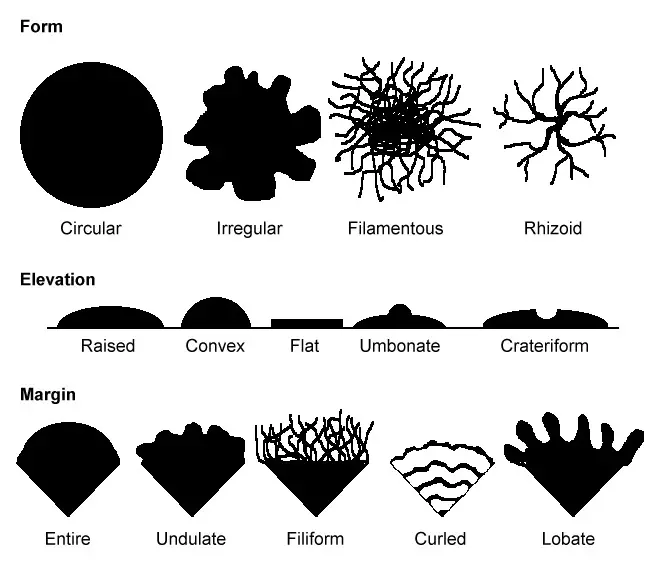Name the Characteristics Used to Describe Bacterial Colonies
A swab from a bin spread directly onto nutrient agar. Colonies need to be well isolated from other colonies to observe the characteristic shape size color surface appearance and texture.
What Are The Five Characteristics Of Bacterial Colony Morphology Quora
Bacterial colonies appear on agar media as tiny dots.
. Define a bacterial colony. The appearance of the colony can be used to identify bacteria as different bacteria produce different-looking colonies. The Characteristics used to describe the morphology of bacterial colonies are the shape size color and texture.
It can be used to help to identify them. Lab 2 Assignment Aseptic Technique. Colony morphology is the visual culture characteristics of a bacterial colony on an agar plate.
The characteristics of a colony shape size margin form elevation pigmentation and consistency are termed the colony morphology. Colony morphology is one of the cultural characteristics of a bacterial colony that is visible on an agar plate. The colony characteristics vary widely.
The form of the colony is subdivided into following. Pure bacterial colonies. Different species of bacteria have different colony characteristics when grown on agar media.
A colony arises from a cluster of bacterial cells growing on the surface of a solid medium. Description of a colonys morphology includes its shape the margins or edges of the colony its color and surface features. These properties are referred to as colonial morphology Figure 22.
Colonies that differ in appearance are typically different bacterial strains species or genera. Pulvinate very convex Umbonate raised in the center Target-shaped. Some of these colony characteristics are.
Edge of the colony can be seen through a magnifier. Shape of the colony. _____ a shiny moist threadlike growth with smooth edges.
A colony that is described as filiform and buttery would have the following characteristics. Surface it pertains to the appearance of the colonys surface such as rough smooth glistening dull or wrinkled. As we document our discoveries it is absolutely essential that we use common adjectives to describe the physical characteristics of the colonies that our isolates form when cultivated on an agar surface.
Colony morphology is a method that scientists use to describe the characteristics of an individual colony of bacteria growing on agar in a Petri dish. The edge of a colony can also be helpful characteristic in. -Size -Shape -Color also known as pigmentation -Texture -Height elevation -Edge margin Key features of bacterial colonies are important criteria for their identification.
Below is an illustrated guide to the terms we will use. A colony is defined as a visible mass of microorganisms all originating from a single mother cell therefore a colony constitutes a clone of bacteria all genetically alike. The term colony morphology refers to the visible characteristics of a colony.
Name the characteristics used to describe bacterial colonies. Observing colony morphology is an important skill used in the microbiology laboratory to identify microorganisms. Colony characteristics for Staphylococcus aureus on blood agar after 18 to 24 hours incubation at 35 C include all the following EXCEPT.
Colony Morphology These characters used to accurately describe the morphology of a bacterial colony. These colonies show different characteristics which are very important in differentiation and identification of bacterial species. They are size shape texture opacity pigmentation mar.
The terms used to. Describing Colony Morphology. Colony morphology is A cluster of identical cells on a solid media.
Colony Morphology is the appearance of the bacterial colony that can be important when identifying a certain species. Bacterial colonies differ in the colony size shape colour texture elevation margins appearance of the. We can predict the type of the bacteria growing on the plate by the shape of the colony.
In the identification of bacteria and fungi much weight is placed on how the organism grows in. Distinguish between a pure culture and a mixed culture. The morphology of a colony results from characteristics of the individual bacteria viewed collectively.
These properties include shape margin elevation size texture appearance pigmentation and optical properties. Define a bacterial colony. The characteristics used to describe the bacterial colonies are shape size margins color texture and elevation.
Some colonies are round and smooth others can have wavy edges and a wrinkled appearance. Swarming smooth white round. The differences in growth patterns for bacteria suspended in a broth culture may be due to the ______.
However colony morphology is not a reliable way to identify bacteria as many different types of bacteria have similar colony morphology. Up to 24 cash back Colony ElevationsDepressions. Size of the colony The size of the colony is determined by its diameter and measured in millimeters.
Colony morphology and pigmentation As bacteria differ in the shape texture color and size of the colonies they can be differentiated and identified to a certain extend by colony morphology. Convex rounded Concave depressedsunken in Flat. Color of the Colony.
When an agar plate is inoculated why is the loop sterilized after the initial inoculum is put on. There are an amazing variety of bacterial colony types. List four characteristics by which bacterial colonies may be distinguished.

Bacteriological Culture Methods Microbiology A Laboratory Experience

Colony Morphology Of Bacteria Microbe Online

What Colony Characteristics Can Be Used For Differentiation Lisbdnet Com
Comments
Post a Comment